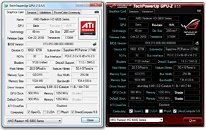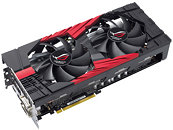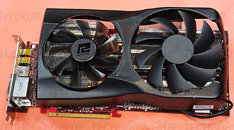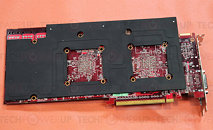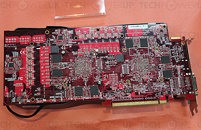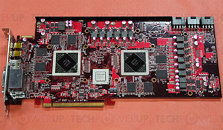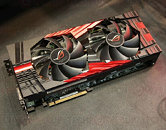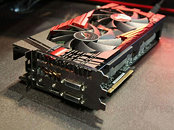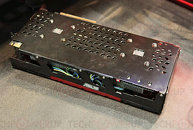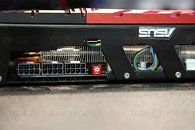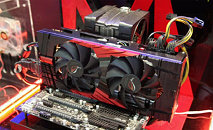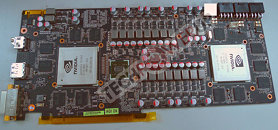Apr 19th, 2025 12:15 EDT
change timezone
Latest GPU Drivers
New Forum Posts
- The TPU UK Clubhouse (26146)
- It's happening again, melting 12v high pwr connectors (1031)
- RX 9000 series GPU Owners Club (406)
- (Some of) What I'd like to See From a Final Fantasy IX Remake (32)
- GPU Pricing and Performance (28)
- DTS DCH Driver for Realtek HDA [DTS:X APO4 + DTS Interactive] (2147)
- Looking for 4060 MXM-A VBIOS (16)
- Looking for Palit 5090 Gamerock OC BIOS (24)
- Dangerous RAM temps? (6)
- Help For XFX RX 590 GME Chinese - Vbios (14)
Popular Reviews
- ASUS GeForce RTX 5060 Ti TUF OC 16 GB Review
- NVIDIA GeForce RTX 5060 Ti PCI-Express x8 Scaling
- ASRock X870E Taichi Lite Review
- Palit GeForce RTX 5060 Ti Infinity 3 16 GB Review
- Teevolution Terra Pro Review
- ASUS GeForce RTX 5060 Ti Prime OC 16 GB Review
- MSI GeForce RTX 5060 Ti Gaming OC 16 GB Review
- Zotac GeForce RTX 5060 Ti AMP 16 GB Review
- MSI GeForce RTX 5060 Ti Gaming Trio OC 16 GB Review
- G.SKILL Trident Z5 NEO RGB DDR5-6000 32 GB CL26 Review - AMD EXPO
Controversial News Posts
- NVIDIA GeForce RTX 5060 Ti 16 GB SKU Likely Launching at $499, According to Supply Chain Leak (182)
- NVIDIA Sends MSRP Numbers to Partners: GeForce RTX 5060 Ti 8 GB at $379, RTX 5060 Ti 16 GB at $429 (127)
- Nintendo Confirms That Switch 2 Joy-Cons Will Not Utilize Hall Effect Stick Technology (105)
- NVIDIA Launches GeForce RTX 5060 Series, Beginning with RTX 5060 Ti This Week (104)
- Over 200,000 Sold Radeon RX 9070 and RX 9070 XT GPUs? AMD Says No Number was Given (100)
- Nintendo Switch 2 Launches June 5 at $449.99 with New Hardware and Games (99)
- Sony Increases the PS5 Pricing in EMEA and ANZ by Around 25 Percent (85)
- NVIDIA PhysX and Flow Made Fully Open-Source (77)
News Posts matching #MARS II
Return to Keyword Browsing
TechPowerUp GPU-Z 0.5.5 Released
TechPowerUp today announced the latest version of GPU-Z, the graphics hardware information and diagnostic utility trusted by the PC enthusiast community at large. Version 0.5.5 comes with support for the latest graphics processors, makes the interface a little more accessible to users, and improves stability and reliability.
To begin with, GPU-Z 0.5.5 adds full support for AMD A-Series accelerated processing units (the Radeon GPU component embedded in them), a load of new and lesser-known GPUs from NVIDIA including GeForce GT 560 Ti OEM, GT 545, GT 530, GeForce GTX 580M, GT 555M, GeForce 520MX, GT 520M, 410M, 305M, Quadro 5000, Quadro 4000M, Quadro 400; from AMD including Radeon HD 6290, Radeon E6760 & E4690, FirePro V8800, FirePro V3700, FirePro 2460 (FireMV); and the recently launched ASUS ROG MARS II, which probably got Santa's inbox flooded by now.DOWNLOAD: TechPowerUp GPU-Z 0.5.5 | TechPowerUp GPU-Z 0.5.5 ASUS ROG Edition
To begin with, GPU-Z 0.5.5 adds full support for AMD A-Series accelerated processing units (the Radeon GPU component embedded in them), a load of new and lesser-known GPUs from NVIDIA including GeForce GT 560 Ti OEM, GT 545, GT 530, GeForce GTX 580M, GT 555M, GeForce 520MX, GT 520M, 410M, 305M, Quadro 5000, Quadro 4000M, Quadro 400; from AMD including Radeon HD 6290, Radeon E6760 & E4690, FirePro V8800, FirePro V3700, FirePro 2460 (FireMV); and the recently launched ASUS ROG MARS II, which probably got Santa's inbox flooded by now.DOWNLOAD: TechPowerUp GPU-Z 0.5.5 | TechPowerUp GPU-Z 0.5.5 ASUS ROG Edition

ASUS Reveals the Republic of Gamers MARS II with Dual GeForce GTX 580 GPUs
The new ROG MARS II picks up where previous graphics card powerhouses from ASUS ROG left off, and continues the legacy of the finest hardware for hardcore gamers. The limited-edition card is built on twin NVIDIA GeForce GTX 580 GPUs and a mammoth 3GB of GDDR5 video memory, with a proprietary ROG design that combines extreme cooling and extensive tuning facilities that cater to the most demanding power user. It also offers colossal pixel-pushing output that is unmatched by any graphics card.

PowerColor to Challenge ASUS MARS II with Monstrous Dual-HD 6970 Graphics Card
While between the GeForce GTX 580 and Radeon HD 6970, the former is clearly the faster graphics card, the two share a disputed lead over each other in their dual-GPU avatars, GeForce GTX 590 and Radeon HD 6990, attributed to the HD 6990 sustaining clock speeds closer to those on its single-GPU implementation, and a better electrical design. While NVIDIA is fixing the electricals on a revised PCB design scheduled for release in the weeks to come, companies like ASUS are wasting no time in designing their own PCBs that can let the two NVIDIA GF110 GPUs sustain clock speeds identical to those on the single-GPU GTX 580. This would pose serious competition to the HD 6990. To ward that off, PowerColor is working on a new Radeon HD 6970 X2 graphics card, which has two AMD Cayman GPUs clocked on par with single-GPU HD 6970, and having the same overclocking headroom.
The new card from PowerColor is not just an overclocked HD 6990, but also has the overclocking headroom of the HD 6970. Further, unlike the HD 6990, it uses Lucid Hydra technology. The PLX-made, AMD-branded PCI-Express bridge chip is replaced by a LucidLogix-made bridge chip that gives each GPU PCI-Express 2.0 x16 bandwidth. Users can run the two GPUs in either AMD CrossFire (with Hydra features disabled), or enable Lucid Hydra Engine features, and let the two GPUs work in tandem with any other graphics card installed in the system, that uses GPUs of any make and generation.
The new card from PowerColor is not just an overclocked HD 6990, but also has the overclocking headroom of the HD 6970. Further, unlike the HD 6990, it uses Lucid Hydra technology. The PLX-made, AMD-branded PCI-Express bridge chip is replaced by a LucidLogix-made bridge chip that gives each GPU PCI-Express 2.0 x16 bandwidth. Users can run the two GPUs in either AMD CrossFire (with Hydra features disabled), or enable Lucid Hydra Engine features, and let the two GPUs work in tandem with any other graphics card installed in the system, that uses GPUs of any make and generation.

ASUS MARS II Graphics Card Pictured
The Republic of Gamers MARS II, detailed earlier, is a new custom dual-GF110 based graphics card in the works at ASUS. Here are some of its first pictures, revealing a monstrosity that's about as long as a Radeon HD 5970, a couple of inches higher, and three slots thick. Its cooler sticks to the black+red color scheme in use with ASUS ROG products for a while now, and uses an intricate cutout design.
The shroud suspends two 120 mm high-sweep fans that blow air on to two heatsinks with highly dense aluminum fin arrays to which heat is fed by copper heat pipes. The card draws power from three 8-pin PCI-Express power connectors. The card uses two NVIDIA GF110 GPUs with the same core configuration and clock profile as GeForce GTX 580, effectively making MARS II a dual-GTX 580, which also provides the overclocking headroom of a GTX 580, something impossible on a NVIDIA GeForce GTX 590.
The shroud suspends two 120 mm high-sweep fans that blow air on to two heatsinks with highly dense aluminum fin arrays to which heat is fed by copper heat pipes. The card draws power from three 8-pin PCI-Express power connectors. The card uses two NVIDIA GF110 GPUs with the same core configuration and clock profile as GeForce GTX 580, effectively making MARS II a dual-GTX 580, which also provides the overclocking headroom of a GTX 580, something impossible on a NVIDIA GeForce GTX 590.

ASUS Designs MARS II Dual-GTX 580 Graphics Card for GeForce Enthusiasts
When ASUS first set out to build the MARS, a dual-GeForce GTX 285 graphics card, people thought the designers were crazy. NVIDIA could barely get the two 55 nm G200b GPUs on GeForce GTX 295 to run at GTX 285 specifications of 240 shaders and 512-bit GDDR3 each, and instead ran them with 448-bit wide GDDR3 memory interface, and lower clocks. ASUS managed to back two GPUs with insanely strong VRM and cooling, to achieve a dual-GPU graphics card that was more than just a GTX 295 overclocked. ASUS is back on the drawing boards with MARS II, a new dual-GPU graphics card that runs two GF110 GPUs in the same exact config as on GeForce GTX 580, perhaps with clock speeds higher than those of GTX 580.
The GeForce GTX 590 runs two GF110 GPUs with all CUDA cores and the complete width of the memory bus enabled, but the GPUs and memory are clocked significantly lower at 607 MHz core, 1214 MHz CUDA cores, and 3.42 GHz memory; while the single-GPU GTX 580 runs at 772 MHz core, 1544 MHz CUDA cores, and 4.00 GHz memory. MARS II also aims to get over the various design pitfalls of GTX 590 that made voltage-assisted overclocking practically impossible on air-cooling. To do this, MARS II will make use of a massive 19-phase VRM with Super Alloy chokes. To cool the beast, ASUS will put to use the expertise it gathered over time with its DirectCu series video card coolers. The new cooler will provide uniform cooling to both GPUs. More details, particularly about the when the card will be released, are awaited.
The GeForce GTX 590 runs two GF110 GPUs with all CUDA cores and the complete width of the memory bus enabled, but the GPUs and memory are clocked significantly lower at 607 MHz core, 1214 MHz CUDA cores, and 3.42 GHz memory; while the single-GPU GTX 580 runs at 772 MHz core, 1544 MHz CUDA cores, and 4.00 GHz memory. MARS II also aims to get over the various design pitfalls of GTX 590 that made voltage-assisted overclocking practically impossible on air-cooling. To do this, MARS II will make use of a massive 19-phase VRM with Super Alloy chokes. To cool the beast, ASUS will put to use the expertise it gathered over time with its DirectCu series video card coolers. The new cooler will provide uniform cooling to both GPUs. More details, particularly about the when the card will be released, are awaited.

ASUS Working on MARS II Dual GTX 480 Graphics Accelerator
After treating the enthusiast community to the Republic of Gamers (ROG) ARES Dual HD 5870 graphics accelerator, ASUS isn't wasting any time is designing its successor, referred to (for now) as "MARS II". This graphics accelerator uses two NVIDIA GeForce GTX 480 (GF100) GPUs on one board, that's right, the first dual-GPU accelerator based on GF100, which is dreaded for its thermal and electrical characteristics so much, that NVIDIA is content with having the second-fastest graphics card in the market (GTX 480), with no immediate plans of working on a dual-GPU accelerator.
ASUS' ambitious attempt is in the design stage deep inside its R&D, where the design is in an evaluation state. The R&D gave us some exclusive pictures of the MARS II PCB to treat you with. To begin with, the card's basic design is consistent with almost every other dual-GPU NVIDIA card in recent past. There are two independent GPU systems, each with its own VRM and memory, which are interconnected by an internal SLI, and connected to the system bus by an nForce 200 bridge chip. On this card, two GF100 GPUs with the same configuration as GeForce GTX 480 (GF100-375-A3) are used, each having 480 CUDA cores, and connecting to 1536 MB of GDDR5 memory across a 384-bit wide memory interface.
ASUS' ambitious attempt is in the design stage deep inside its R&D, where the design is in an evaluation state. The R&D gave us some exclusive pictures of the MARS II PCB to treat you with. To begin with, the card's basic design is consistent with almost every other dual-GPU NVIDIA card in recent past. There are two independent GPU systems, each with its own VRM and memory, which are interconnected by an internal SLI, and connected to the system bus by an nForce 200 bridge chip. On this card, two GF100 GPUs with the same configuration as GeForce GTX 480 (GF100-375-A3) are used, each having 480 CUDA cores, and connecting to 1536 MB of GDDR5 memory across a 384-bit wide memory interface.
Apr 19th, 2025 12:15 EDT
change timezone
Latest GPU Drivers
New Forum Posts
- The TPU UK Clubhouse (26146)
- It's happening again, melting 12v high pwr connectors (1031)
- RX 9000 series GPU Owners Club (406)
- (Some of) What I'd like to See From a Final Fantasy IX Remake (32)
- GPU Pricing and Performance (28)
- DTS DCH Driver for Realtek HDA [DTS:X APO4 + DTS Interactive] (2147)
- Looking for 4060 MXM-A VBIOS (16)
- Looking for Palit 5090 Gamerock OC BIOS (24)
- Dangerous RAM temps? (6)
- Help For XFX RX 590 GME Chinese - Vbios (14)
Popular Reviews
- ASUS GeForce RTX 5060 Ti TUF OC 16 GB Review
- NVIDIA GeForce RTX 5060 Ti PCI-Express x8 Scaling
- ASRock X870E Taichi Lite Review
- Palit GeForce RTX 5060 Ti Infinity 3 16 GB Review
- Teevolution Terra Pro Review
- ASUS GeForce RTX 5060 Ti Prime OC 16 GB Review
- MSI GeForce RTX 5060 Ti Gaming OC 16 GB Review
- Zotac GeForce RTX 5060 Ti AMP 16 GB Review
- MSI GeForce RTX 5060 Ti Gaming Trio OC 16 GB Review
- G.SKILL Trident Z5 NEO RGB DDR5-6000 32 GB CL26 Review - AMD EXPO
Controversial News Posts
- NVIDIA GeForce RTX 5060 Ti 16 GB SKU Likely Launching at $499, According to Supply Chain Leak (182)
- NVIDIA Sends MSRP Numbers to Partners: GeForce RTX 5060 Ti 8 GB at $379, RTX 5060 Ti 16 GB at $429 (127)
- Nintendo Confirms That Switch 2 Joy-Cons Will Not Utilize Hall Effect Stick Technology (105)
- NVIDIA Launches GeForce RTX 5060 Series, Beginning with RTX 5060 Ti This Week (104)
- Over 200,000 Sold Radeon RX 9070 and RX 9070 XT GPUs? AMD Says No Number was Given (100)
- Nintendo Switch 2 Launches June 5 at $449.99 with New Hardware and Games (99)
- Sony Increases the PS5 Pricing in EMEA and ANZ by Around 25 Percent (85)
- NVIDIA PhysX and Flow Made Fully Open-Source (77)
